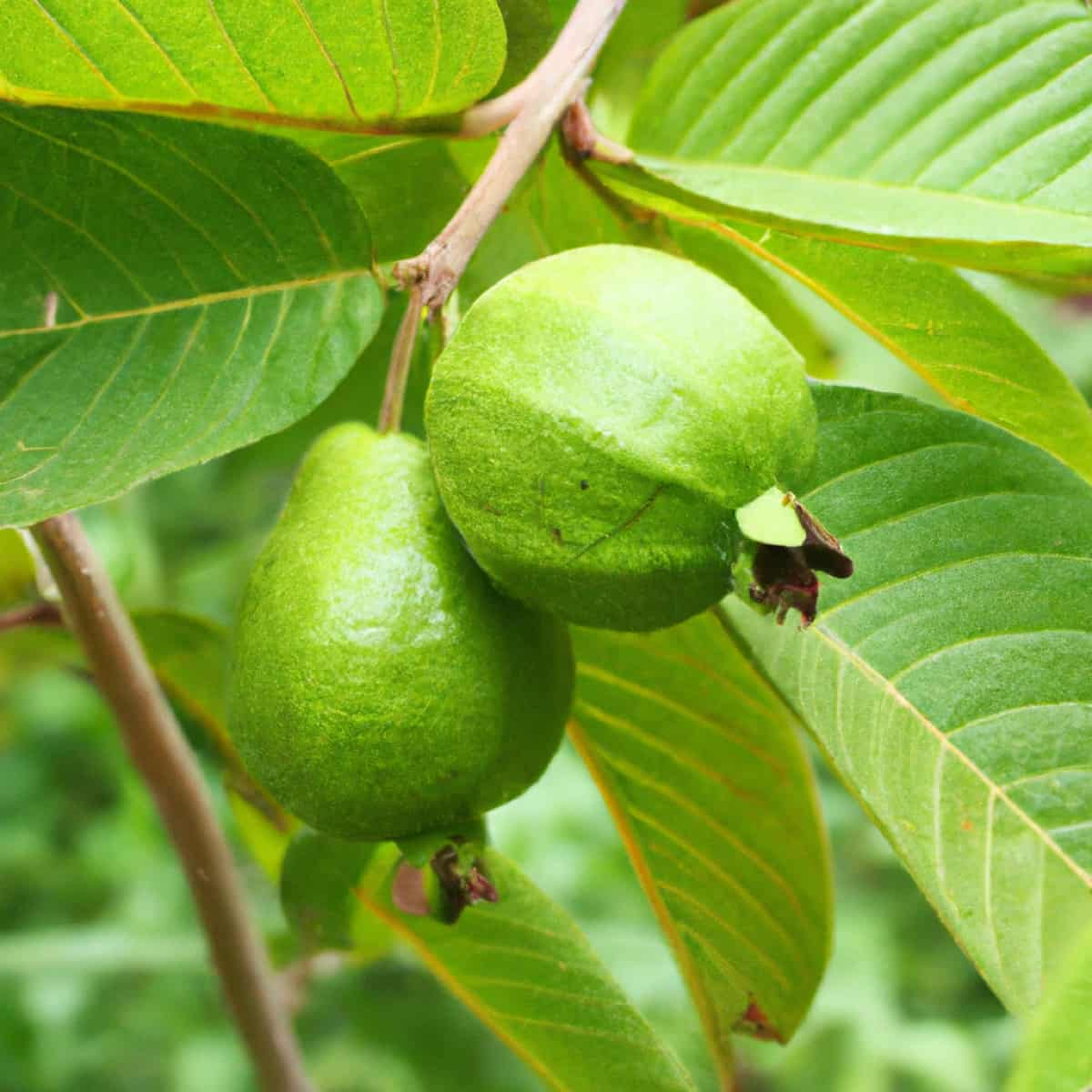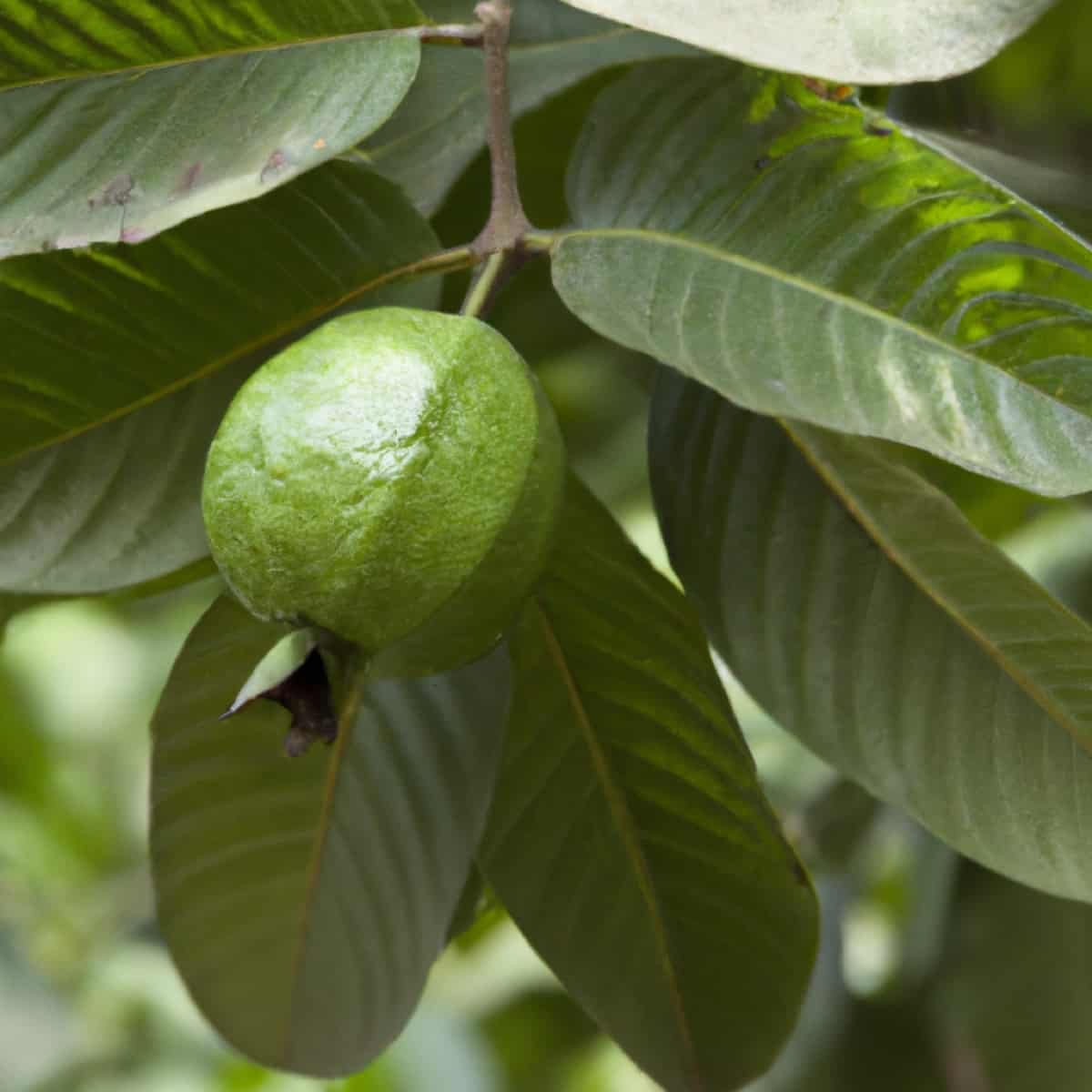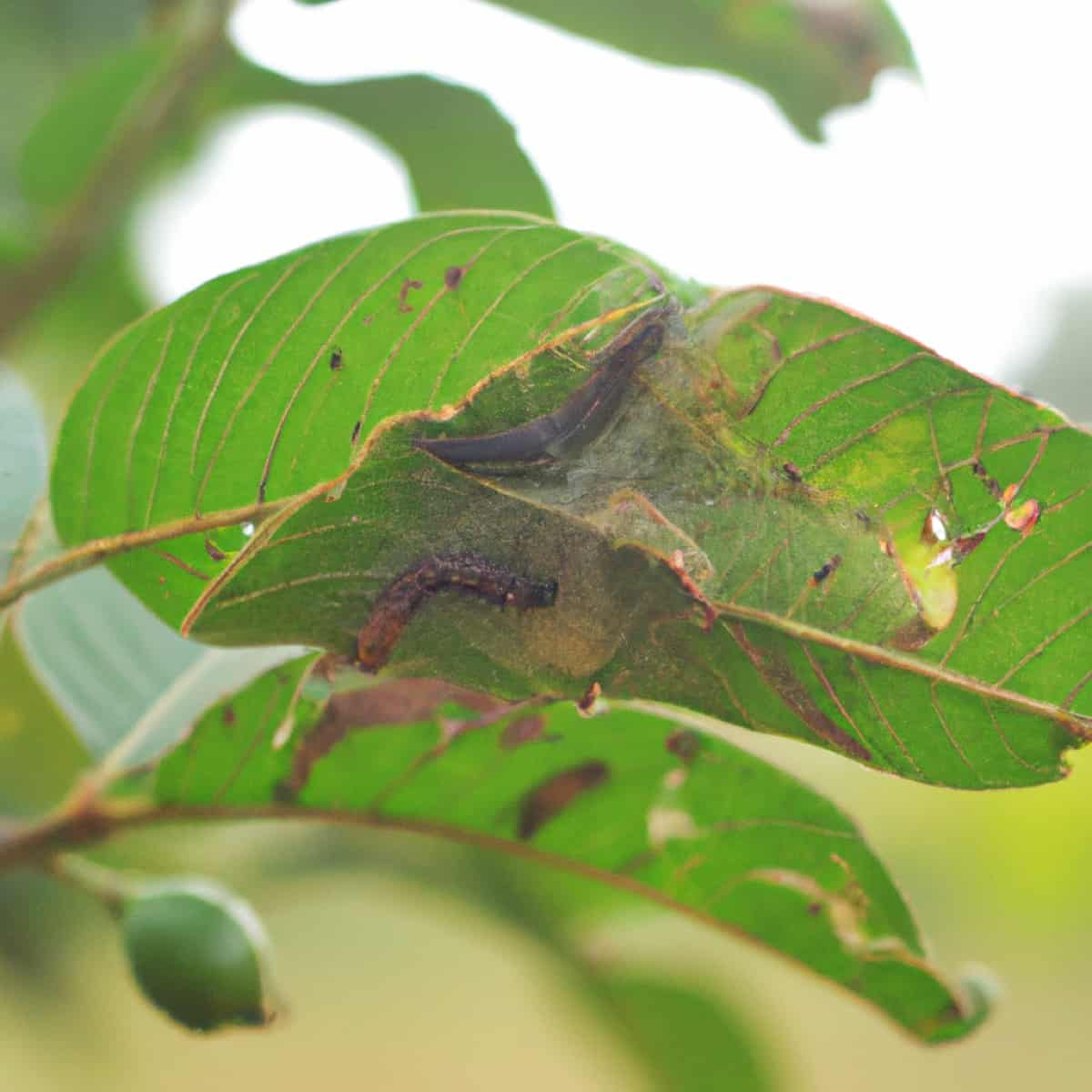Guava is a delicious tropical fruit loved by many, but it is also highly susceptible to various pests that can wreak havoc on the plant and its fruits. This blog post will explore the major pests that infest guava trees, their identification, and the damage they can cause. We will also discuss effective methods of prevention and control to help you protect your guava plants and ensure a healthy harvest. So, let’s check out how to treat pests of Guava tree below.

Major and Common Pests of Guava: Identification and Symptoms
Fruit fly: The adult fruit fly is brown or dark brown with hyaline wings and yellow legs. Symptoms: Fruit fly adults and maggots target semi-ripe fruits. Look for oviposition punctures on the fruits. Maggots destroy the pulp, turning it into a bad-smelling, discolored semi-liquid mass.
Guava fruit borers/pomegranate butterfly: The adult butterfly is bluish-brown with a V-shaped patch on the forewing. Symptoms: Caterpillars bore into young fruits, feeding on the internal contents and making the fruit hollow. Infested fruits may rot and drop prematurely.
Castor capsule borer: The adult moth is yellow-colored with black dots. Symptoms: Larvae bore into stems and damaged capsules. They may also attack buds and tender shoots. Infected fruits dry up, become deformed, and fall off before ripening.
Bark-eating caterpillar: The adult moth is white with small black dots on the thorax and numerous spots and streaks on the forewings. Symptoms: Look for irregular tunnels and patches covered with silken webs on shoots, branches, stems, and the main trunk. Holes on the trunk with wood dust and fecal matter indicate infestation. Severe damage can lead to stem death, and larvae can be found beneath fresh webbing.
Tea mosquito bug: The adult bug is reddish-brown with a black head, red thorax, black and white abdomen, and a knob-like process on the mid-dorsal thorax. Symptoms: Nymphs and adults puncture petioles, tender shoots, and fruits. Brownish-black necrotic patches develop on foliage. Elongate streaks and patches can appear on shoots, while corky scab formation may occur on fruits.
Mealy bug: The adult female is apterous, long, slender, and covered with white waxy secretions. Symptoms: Mealybugs suck sap from twigs, leaves, and flowers, leading to the development of unevenly shaped and poor-quality fruits. They are major pests of vegetables, ornamental plants, and tropical orchard trees, attacking various plant species.
Aphid: Adult aphids come in small, winged, wingless forms that reproduce parthenogenetically. Symptoms: Nymphs and adults suck sap from leaves, shoots, and fruits. Look out for yellowing leaves and wilting of terminal shoots.
Whitefly: Adult whiteflies are small, winged insects with light yellow bodies covered in white waxy powder. Symptoms: Whitefly infestations cause chlorotic spots, Yellowing, downward curling, and drying of leaves. Additionally, whiteflies act as vectors for potato leaf curl disease.
How to Treat Pests of Guava Tree
Thrips (Red Banded Thrips) Pest Management in Guava
Thrips are small insects, about 1.5mm in size, with a slender shape. They have a dark brown to black coloration, and the female thrips have a red color on the abdominal segments.
- Distribution: Thrips are commonly found in tropical and non-tropical countries.
- Other Host Plants: Thrips can infest cashew, pineapple, apple, and cereals.
- Symptoms: Coarse stippling on the guava plant leaves, Silvery appearance on the leaves, Distortion of leaves.
Management of Thrips
- Apply reflective mulches early in the growing season.
- Avoid planting guava near onions, cereals, and garlic.
- Timely application of insecticides.
Tea Mosquito Bug Pest Management in Guava
The female tea mosquito bug inserts around 32 eggs into the tender shoot, inflorescence axis, and tender fruits of the guava plant. The eggs take about 7-8 days to hatch, and the nymphal stage lasts approximately 14-16 days. The entire life cycle of this pest is completed within 22-25 days.
In case you missed it: How to Treat Common Guava Fruit Diseases: Symptoms, Causes, and Management

- Distribution and Status: Tea mosquito bugs are found in regions such as Karnataka, Goa, Maharashtra, and Tamil Nadu.
- Other Host Plants: Tea mosquito bugs can also infest cashew, tea, moringa, and neem.
- Symptoms: The appearance of necrotic lesions and brownish-black patches on shoots, Formation of blisters and scales on affected fruits, Rusty corky growth and scab on fruits, Loss of plant vigor, drying of shoots, fruit shedding, and flower inflorescence issues.
Management of Tea Mosquito Bug
- Prune the guava plant to allow better air circulation.
- Thin out dense canopy.
- Apply preventive measures on time.
- Use appropriate insecticides.
Root Knot Nematode Pest Management in Guava
- Description: Nematodes are parasitic worms that cause significant damage to plants, leading to reduced crop yield and quality.
- Distribution: Nematodes are commonly found in sandy soil.
- Other Host Plants: Nematodes can infest various commercial and food crops.
- Symptoms: The appearance of small galls up to 3.3cm in diameter, Decrease in plant yield and quality, Distorted and underdeveloped plants, Yellowing of leaves and fruits, and wilting of the plant.
Management of Root Knot Nematode
- Apply green manure to improve soil structure.
- Replace the soil around the roots with moist, heated soil if nematodes are present.
- Use non-fumigant and fumigant treatments to destroy nematodes.
- Plant-resistant varieties of guava.
Fruit Fly Pest Management in Guava
- Description: Fruit flies (Bactrocera diversus) affect the quality of fruits in various plants, including guava. The female fruit fly lays eggs on the soft skin of guava fruits, and the entire life cycle egg to adult takes about 7-13 days.
- Distribution: Fruit flies are found in most tropical and subtropical countries.
- Other Host Plants: Fruit flies can infest tomatoes, oranges, mango, and apple.
- Symptoms: Small cavities and dark greenish punctures on affected fruits, Wriggling maggots inside the affected fruits, Rotting and falling of the affected fruits.
Management of Fruit Fly
- Gather and burn all affected plants.
- Apply timely preventive measures to expose and destroy young pups.
Guava Whitefly Pest Management in Guava
- Description: Guava whiteflies (Trialeurodes vaporariorum) are small, sap-sucking insects that infest guava plants, causing damage and reducing plant vigor.
- Distribution: Guava whiteflies are found in various regions, including tropical and subtropical areas.
- Other Host Plants: Guava whiteflies can infest tomatoes, citrus, and other fruit and vegetable crops.
- Symptoms: White, powdery wax deposits on leaves and stems, Stunted growth and Yellowing of leaves, Honeydew secretion, and the growth of sooty mold on affected plant parts.
Management of Guava Whitefly
- Monitor populations and apply biological control agents, such as parasitic wasps.
- Use insecticidal soaps or oils to control whitefly infestations.
- Remove heavily infested plant parts and dispose of them properly.
In case you missed it: Management of Fruit Borer in Guava: Symptoms, Treatment, Chemical, Biological, Natural, and Organic Control

Conclusion
To effectively manage common guava pests, such as guava whitefly, mealy bug, tea mosquitoes, and aphids, it is important to recognize their symptoms, practice preventive measures like pruning and sanitation, and use appropriate control methods such as fungicides and biological agents.
- Beneficial Insects in Pest Management
- Natural Solutions for Pest Control in Flower Gardens
- Types of Fungicides Used in Agriculture
- Common Issues in the Fruit Development Stage of Pomegranate Farming
- Fruit Development Issues in Papaya: Easy Solutions and Treatment
- Soil-Borne Diseases and How to Protect Your Plants
- Practices to Prevent Disease Spread in the Garden
- From Wilted to Thriving: How to Treat Root Rot Naturally in Houseplants
- Natural Remedies to Cure Brown Spots on Fig Tree Leaves